Try to put 7.000 rhinos in a row next to each other
Elephant Management and Poaching in African Countries
- Lisbeth
- Site Admin
- Posts: 67388
- Joined: Sat May 19, 2012 12:31 pm
- Country: Switzerland
- Location: Lugano
- Contact:
Re: Elephant Poaching in Africa (Kenya, Tanzania, ...)
200.000 elephants  The number of inhabitants in two small towns
The number of inhabitants in two small towns 


Try to put 7.000 rhinos in a row next to each other

Try to put 7.000 rhinos in a row next to each other
"Education is the most powerful weapon which you can use to change the world." Nelson Mandela
The desire for equality must never exceed the demands of knowledge
The desire for equality must never exceed the demands of knowledge
- Lisbeth
- Site Admin
- Posts: 67388
- Joined: Sat May 19, 2012 12:31 pm
- Country: Switzerland
- Location: Lugano
- Contact:
Re: Elephant Poaching in Other African Countries
Zimbabwe's women's anti-poaching group protecting elephants - BBC News
Vimbai is a ranger in Zimbabwe's armed female anti-poaching unit, Akashinga. They protect one of the biggest elephant populations in Africa.
BBC News looks into how the group has managed to be so effective, following them as they patrol
"Education is the most powerful weapon which you can use to change the world." Nelson Mandela
The desire for equality must never exceed the demands of knowledge
The desire for equality must never exceed the demands of knowledge
- Lisbeth
- Site Admin
- Posts: 67388
- Joined: Sat May 19, 2012 12:31 pm
- Country: Switzerland
- Location: Lugano
- Contact:
Re: Elephant Poaching in Other African Countries
Third arrest made as China customs dismantle major ivory trafficking syndicate
Posted on 17 January, 2019 by News Desk in News, Poaching, Wildlife and the News Desk post series.
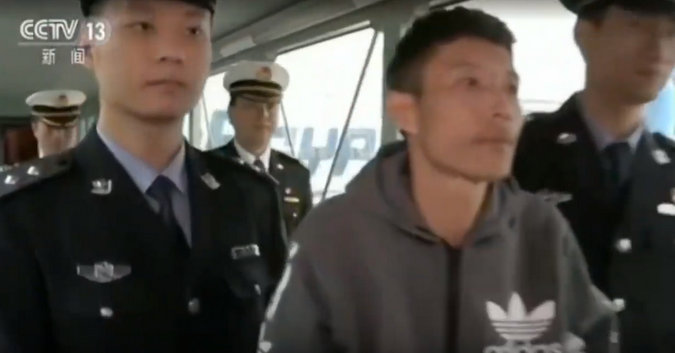
Screen capture from video footage of Ou Haiqiang with Chinese authorities in January 2019. Source: EIA
Chinese authorities have nabbed all three identified members of a major ivory trafficking syndicate first exposed by the London-based Environmental Investigation Agency (EIA) in 2017, according to a statement released by EIA.
In the 2017 report titled The Shuidong Connection: Exposing the global hub of the illegal ivory trade, EIA revealed that the largest hub for ivory trafficking is based in Shuidong, a small remote town in the southern province of Guangdong in China. The exposé was the result of three years of undercover operations during which EIA investigators infiltrated one of the Shuidong groups and detangled the syndicate’s modus operandi, from the methods the group used to source raw elephant tusks to shipping and selling the tusks in China and managing profits. According to the Shuidong group, up to 80% of all poached ivory that made its way to China from Africa was first smuggled to Shuidong.
EIA investigators identified three men from the syndicate – Ou Haiqiang, Xie Xingbang and Wang Kangwen – and confidentially shared the information with relevant Chinese authorities before the report was published. They shared the information with the urgent recommendation that China would use this new information to crack down on this illegal activity. In an impressively prompt response, the China Customs Anti-Smuggling Bureau (ASB) launched an extensive raid involving up to 500 officers in several locations in Shuidong and surrounding areas.
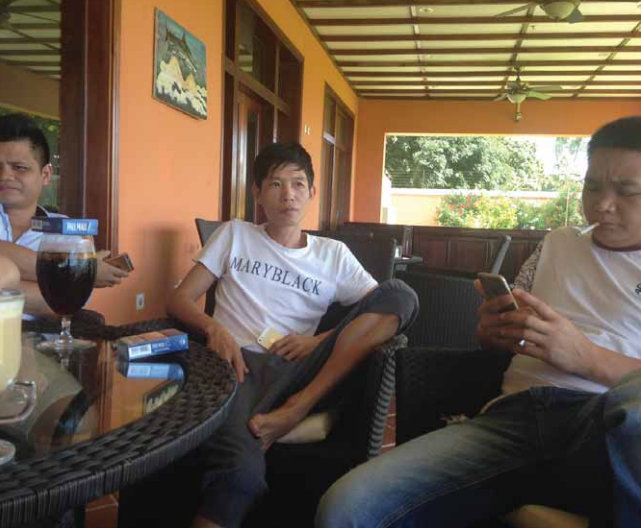
Xie, Ou and Wang meet with investigators in 2016 © EIA
Wang Kangwen was arrested during the raid and received a jail term of 15 years. Xie Xingbang, based in Tanzania at that time, voluntarily returned to face trial, after which he was jailed for six years.
Finally, the China Customs ASB announced on 5 January 2019 it had apprehended and repatriated Ou, the last of the three main culprits linked to the Shuidong wildlife crime syndicate, from Nigeria.
“We are very pleased to see such robust enforcement action taken by the Chinese authorities in response to the information provided by our investigators,” said Julian Newman, our Campaigns Director.
Chinese law enforcement actions based on EIA’s intelligence have now led to the dismantling of two ivory trafficking syndicates in southern China and the apprehension of multiple criminals.
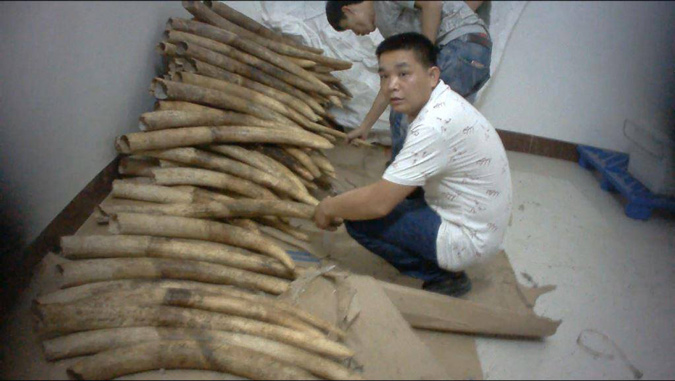
In October 2016, after months of negotiation, EIA investigators finally convinced the smugglers to show them part of the 2.3 tonne ivory shipment they had arranged back in April 2016 © EIA
Watch footage of the arrests below (© EIA)
Posted on 17 January, 2019 by News Desk in News, Poaching, Wildlife and the News Desk post series.

Screen capture from video footage of Ou Haiqiang with Chinese authorities in January 2019. Source: EIA
Chinese authorities have nabbed all three identified members of a major ivory trafficking syndicate first exposed by the London-based Environmental Investigation Agency (EIA) in 2017, according to a statement released by EIA.
In the 2017 report titled The Shuidong Connection: Exposing the global hub of the illegal ivory trade, EIA revealed that the largest hub for ivory trafficking is based in Shuidong, a small remote town in the southern province of Guangdong in China. The exposé was the result of three years of undercover operations during which EIA investigators infiltrated one of the Shuidong groups and detangled the syndicate’s modus operandi, from the methods the group used to source raw elephant tusks to shipping and selling the tusks in China and managing profits. According to the Shuidong group, up to 80% of all poached ivory that made its way to China from Africa was first smuggled to Shuidong.
EIA investigators identified three men from the syndicate – Ou Haiqiang, Xie Xingbang and Wang Kangwen – and confidentially shared the information with relevant Chinese authorities before the report was published. They shared the information with the urgent recommendation that China would use this new information to crack down on this illegal activity. In an impressively prompt response, the China Customs Anti-Smuggling Bureau (ASB) launched an extensive raid involving up to 500 officers in several locations in Shuidong and surrounding areas.

Xie, Ou and Wang meet with investigators in 2016 © EIA
Wang Kangwen was arrested during the raid and received a jail term of 15 years. Xie Xingbang, based in Tanzania at that time, voluntarily returned to face trial, after which he was jailed for six years.
Finally, the China Customs ASB announced on 5 January 2019 it had apprehended and repatriated Ou, the last of the three main culprits linked to the Shuidong wildlife crime syndicate, from Nigeria.
“We are very pleased to see such robust enforcement action taken by the Chinese authorities in response to the information provided by our investigators,” said Julian Newman, our Campaigns Director.
Chinese law enforcement actions based on EIA’s intelligence have now led to the dismantling of two ivory trafficking syndicates in southern China and the apprehension of multiple criminals.

In October 2016, after months of negotiation, EIA investigators finally convinced the smugglers to show them part of the 2.3 tonne ivory shipment they had arranged back in April 2016 © EIA
Watch footage of the arrests below (© EIA)
"Education is the most powerful weapon which you can use to change the world." Nelson Mandela
The desire for equality must never exceed the demands of knowledge
The desire for equality must never exceed the demands of knowledge
- Lisbeth
- Site Admin
- Posts: 67388
- Joined: Sat May 19, 2012 12:31 pm
- Country: Switzerland
- Location: Lugano
- Contact:
Re: Elephant Management and Poaching in Other African Countries
Baby elephants torn from mothers and shipped 7,000 miles to China (Zimbabwe)
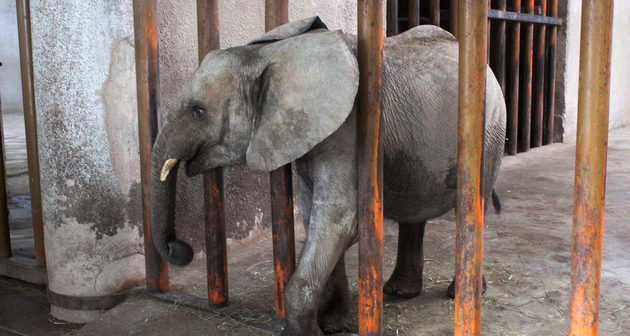
BY JANE FLANAGAN - 9 FEBRUARY 2019 - THE TIMES
Thirty-five young elephants are to be flown from Zimbabwe to zoos in China after being forcibly separated from their mothers in an operation “designed to disorientate, exhaust and subdue” them.
The animals, some as young as two, are being held in pens in Hwange National Park while travel crates are prepared and documents finalised for the 7,000-mile journey.
During the Mugabe era, Zimbabwe’s wildlife was regularly sold to Asia and the Middle East to settle debts. A source close to the operation described how rangers flew helicopters at family groups to isolate the young who were darted and loaded on to trucks.
“It can take several attempts to successfully part the young from their mothers, who are extremely protective,” he told The Times.
“The helicopter has to fly very close in order to create the panic that leaves the young elephants exhausted, disorientated and isolated from the rest of the herd. While the juvenile is being loaded, the helicopter buzzes around the herd to stop the animals from attempting to defend their young.”
A vet from Zimbabwe’s wildlife agency has certified all the young fit enough for the long, stressful journey, which will begin in the coming days with an 80-mile trip by road to the airport at Victoria Falls and on to cargo planes.
The bankrupt country’s fuel crisis hampered the operation and it took months for officials from the Zimbabwe Parks and Wildlife Management Authority, known as ZimParks, to complete the order from China.
A spokesman for ZimParks declined to confirm that elephants had been captured for live export but said: “We never export baby elephants, only sub-adults of four or five years old.”
Conservationists say calves can be entirely dependent on their mothers for emotional and physical support until they are five; others can still be taking their mother’s milk until they are ten or another sibling is born.
Hwange National Park was the site of the killing of Cecil the lion in 2015 by an American trophy hunter. News of the imminent export comes two years after 31 calves were flown to China, creating an international outcry.
Such incidents have tarnished Zimbabwe’s reputation as a tourist detination despite its many spectacular wildlife attractions. The country is now increasingly reliant on its Chinese allies as it is threatened with a return to pariah status amid reports of human rights abuses during recent protests.
Since 2012 about 100 elephant calves have been sold to Chinese zoos and safari parks, some of which offer elephants performing stunts in circus shows. Such deals require permits, under the multilateral Cites treaty that governs the wildlife trade.
The unknown fate of the 35 elephants underlined the lack of oversight over such deals.
Dan Bucknell, executive director of Tusk, the UK elephant charity, said: “People imagine that in this day and age zoos are being restocked from captive breeding, or from zoo-to-zoo transfers, not by animals being taken from the wild. Yet this sort of trade is perfectly legal under Cites.”
Read original article:
https://www.thetimes.co.uk/article/baby ... -dgd37svw3

BY JANE FLANAGAN - 9 FEBRUARY 2019 - THE TIMES
Thirty-five young elephants are to be flown from Zimbabwe to zoos in China after being forcibly separated from their mothers in an operation “designed to disorientate, exhaust and subdue” them.
The animals, some as young as two, are being held in pens in Hwange National Park while travel crates are prepared and documents finalised for the 7,000-mile journey.
During the Mugabe era, Zimbabwe’s wildlife was regularly sold to Asia and the Middle East to settle debts. A source close to the operation described how rangers flew helicopters at family groups to isolate the young who were darted and loaded on to trucks.
“It can take several attempts to successfully part the young from their mothers, who are extremely protective,” he told The Times.
“The helicopter has to fly very close in order to create the panic that leaves the young elephants exhausted, disorientated and isolated from the rest of the herd. While the juvenile is being loaded, the helicopter buzzes around the herd to stop the animals from attempting to defend their young.”
A vet from Zimbabwe’s wildlife agency has certified all the young fit enough for the long, stressful journey, which will begin in the coming days with an 80-mile trip by road to the airport at Victoria Falls and on to cargo planes.
The bankrupt country’s fuel crisis hampered the operation and it took months for officials from the Zimbabwe Parks and Wildlife Management Authority, known as ZimParks, to complete the order from China.
A spokesman for ZimParks declined to confirm that elephants had been captured for live export but said: “We never export baby elephants, only sub-adults of four or five years old.”
Conservationists say calves can be entirely dependent on their mothers for emotional and physical support until they are five; others can still be taking their mother’s milk until they are ten or another sibling is born.
Hwange National Park was the site of the killing of Cecil the lion in 2015 by an American trophy hunter. News of the imminent export comes two years after 31 calves were flown to China, creating an international outcry.
Such incidents have tarnished Zimbabwe’s reputation as a tourist detination despite its many spectacular wildlife attractions. The country is now increasingly reliant on its Chinese allies as it is threatened with a return to pariah status amid reports of human rights abuses during recent protests.
Since 2012 about 100 elephant calves have been sold to Chinese zoos and safari parks, some of which offer elephants performing stunts in circus shows. Such deals require permits, under the multilateral Cites treaty that governs the wildlife trade.
The unknown fate of the 35 elephants underlined the lack of oversight over such deals.
Dan Bucknell, executive director of Tusk, the UK elephant charity, said: “People imagine that in this day and age zoos are being restocked from captive breeding, or from zoo-to-zoo transfers, not by animals being taken from the wild. Yet this sort of trade is perfectly legal under Cites.”
Read original article:
https://www.thetimes.co.uk/article/baby ... -dgd37svw3
"Education is the most powerful weapon which you can use to change the world." Nelson Mandela
The desire for equality must never exceed the demands of knowledge
The desire for equality must never exceed the demands of knowledge
- Lisbeth
- Site Admin
- Posts: 67388
- Joined: Sat May 19, 2012 12:31 pm
- Country: Switzerland
- Location: Lugano
- Contact:
Re: Elephant Management and Poaching in Other African Countries
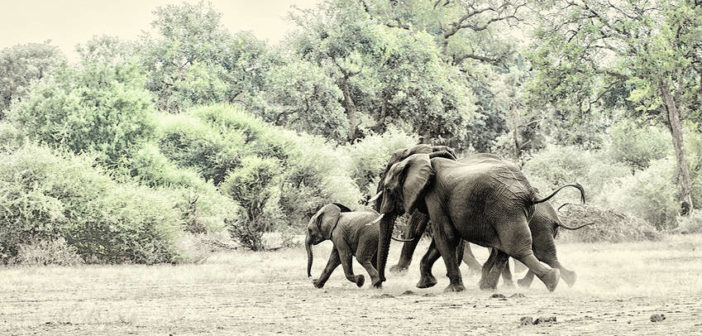
Hwange National Park. Photo: Don Pinnock
[Zimbabwe, CITES attacked over elephant calves
BY ELISE TEMPLEHOFF - 14 FEBRUARY 2019 - BEELD
The Humane Society International (HSI) launched a scathing attack on both the Zimbabwean government and the Convention on International Trade in Endangered Species (CITES) last Tuesday night after 35 elephant calves were removed from their herds in Hwange National Park and are being kept in bomas before they are exported to China.
It is the fourth time since 2012 that Zimbabwe has caught elephant calves for export to China where they are used in zoos or circuses. A total of 108 elephant calves have already been captured in this way and exported to China.
The HSI wrote in a statement: “This is the worst form of abuse of wildlife. And it happens at this moment – again in Zimbabwe where 35 small wild elephants have been torn away from their mothers and are now waiting in bomas to be sent to China.
The HSI, in its statement, refers to a report that appeared in The Times of London a few days ago and was written by a Zimbabwean journalist about the 35 elephant calves being chased one by one into crates while “documentation” is being completed to export them to China.
According to The Times, a journey of over 11 000 km.
HSI says Zimbabwe is continuing to export elephants to China despite fierce opposition from much of the international community, elephant experts and non-governmental and conservation organizations, such as HSI.
“HSI received secret video footage of the conditions in which 14 elephant calves are kept in a Chinese zoo in 2017. The video shows how the elephants are beaten and kicked. They are then injected with an anesthetic before being dragged into cement cages and locked up.
“Zimbabwe exported 30 baby elephants to China in 2016. Many of them died during the long journey. It was shocking to see the surviving elephants: they just stood there, alone in concrete cells,” wrote Kitty Block of the HSI.
According to the HSI, it is especially disturbing that both Zimbabwe and China, who are both supporters of CITES and signed the convention, do not comply with regulations.
CITES are also supposed to sign export permits for elephants. Michele Pickover, of the EMS Foundation, said on Wednesday that CITES had not responded to elephant calf queries so far.
She said CITES is not an animal welfare organization and is only interested in the trading of wild animals and plants. CITES are not interested in animal welfare. She added that CITES is a trading organization.
HSI said 33 conservation organizations wrote an open letter to new Zimbabwean president Emmerson Mnangagwa last year, pleading that the country should stop trading elephants. “Our plea fell on deaf ears,” Block said.
According to HSI, Oppah Muchinguri-Kashiri, Zimbabwe’s environmental affairs minister, recently made a statement in Zimbabwe to export more game so that the country could earn money to plow back into conservation. According to her, the Chinese still want to buy elephants, as well as lions, baboons and hyenas”. We will trade these animals without hesitation. We’re not going to apologize to anyone for this, “she apparently said.
Zimbabwean Game and Park Agency spokeswoman Tinashe Farawo said Zimbabwe had too many elephants and the animals were not threatened. He also pointed out that there is now a lot of conflict between the local people and elephants.
Beeld noted previously “Zimbabwe is deeply indebted to China. China has built a new parliamentary building and military base for Zimbabwe. China has also helped expand the Kariba South Hydro-electric scheme and build three sun farms.
In addition, Zimbabwe apparently owes $ 3.8 million to a Chinese woman, Song Li, chairman of a Chinese investment company in Harare. Song Li is also the owner of Eagle Tannery, which provides military clothing, shoes and belts to Zimbabwean soldiers. Song also has a share in Chinese zoos, safari parks and circuses. Because Zimbabwe has no money to pay Song Li, she indicated she would be satisfied with 200 elephant calves.
Translated from Afrikaans: https://www.pressreader.com/
"Education is the most powerful weapon which you can use to change the world." Nelson Mandela
The desire for equality must never exceed the demands of knowledge
The desire for equality must never exceed the demands of knowledge
- Lisbeth
- Site Admin
- Posts: 67388
- Joined: Sat May 19, 2012 12:31 pm
- Country: Switzerland
- Location: Lugano
- Contact:
Re: Elephant Management and Poaching in Other African Countries
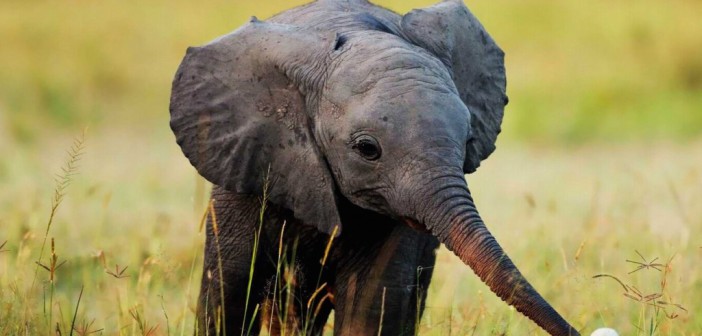
NEW VIDEO: Zimbabwe’s 35 captured baby elephants terrified in pens
BY HUMANE SOCIETY INTERNATIONAL / AFRICA - 25 FEBRUARY 2019 - PRESS RELEASE
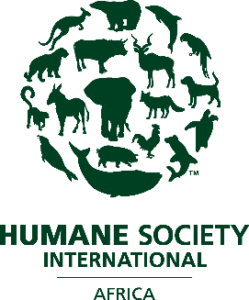
PRESS RELEASE
FOR IMMEDIATE RELEASE
VIDEO: Elephant experts condemn Zimbabwe’s inhumane capture of wild baby elephants for Chinese zoos as video emerges showing animals in distress
CAPE TOWN (25 February 2019) – Elephant experts at Humane Society International/Africa have condemned Zimbabwe’s capture of 35 baby elephants, some as young as two years old, who have been stolen from their mothers and are awaiting export to foreign zoos. According to The Times of London, the young elephants are being held in pens in Hwange National Park while travel crates are prepared and the documents finalised for the detrimental 7,000-mile journey to China. Footage provided to Humane Society International/Africa shows the youngsters frantically pacing around the Hwange pens, some showing signs of stress such as temporal streaming (dark streaks down the side of the face from the temporal gland) and others demonstrating wide-eyed, ear-splayed defensive postures.
Based on the trade data of the Convention on International Trade in Endangered Species of Wild Fauna and Flora (CITES), since 2012 Zimbabwe has exported 108 young elephants to zoos in China despite opposition from other African countries, elephant experts and non-governmental organizations including the Humane Society of the United States and Humane Society International.
Audrey Delsink, Humane Society International/Africa’s wildlife director and an elephant biologist, said: “The capture of baby elephants from the wild is barbaric, and captivity will be a life sentence of suffering. Video footage shows that these young animals are already displaying stress behaviour after being ripped away from their mothers and bonded family groups, and are terrified. Calves normally remain closely bonded to their natal family groups; females never leave their families whilst males only leave the herd at 12 -15 years of age. With no adult females to look to for reassurance, guidance and learning, one can only imagine the youngsters’ distress. Zimbabwe continues to exploit its wildlife to the highest bidder with no meaningful oversight. Recognising elephants as sentient beings, South Africa has banned the capture of elephants from the wild for captivity. Zimbabwe must urgently follow suit to redeem itself.”
Delsink’s sentiments echo those expressed last week by Kenya’s Cabinet Secretary for Tourism & Wildlife speaking at the African Elephant Coalition Summit in Nairobi. The Honourable Najib Balala remarked, “Trade in live elephants should only be for the purpose of enhancing the conservation of the species in its natural habitats (in-situ) as the only appropriate and acceptable destination.” The AEC’s press statement of the Summit called for an end to the export of wild elephants to zoos and other captive facilities. These positions are reflected in the proposals and documents submitted by the AEC to the 18th meeting of the CITES Conference of Parties which will take place this May in Sri Lanka.
Iris Ho, senior wildlife policy and programs specialist at Humane Society International, who attended the Summit, stated: “Ripping baby elephants from their mothers is morally indefensible and ethically reprehensible. We cannot agree more with the Honourable Balala and the African Elephant Coalition regarding the conservation and welfare concerns related to the deliberate capture of wild elephants for the purpose of holding them in permanent captivity outside their natural range.”
In collaboration with the AEC, Humane Society International co-authored a report highlighting the challenges that the live trade in elephants poses to the CITES regulations.
Notes:
- In January 2018, Humane Society International/Africa and 33 partners, submitted a letter to Zimbabwe’s new president, Emmerson Mnangagwa, pleading for a halt to the horrific abuse and practice of capturing elephants from the wild for captivity.
- In October 2017, Humane Society International released exclusive footage of 14 young elephants being held prior to export to Chinese zoos who had been captured from Hwange National Park by the Zimbabwe Parks and Wildlife Management Authority (ZPWMA). The footage showed abusive treatment of the calves as they were beaten and kicked whilst being sedated and taken away to the Park’s holding pens.
- In 2016, Zimbabwe exported 30 baby elephants to Chinese zoos, many of whom died during transit or after arrival. Photos of the few surviving baby elephants, standing alone in dark, barren cells, were shocking.
- The African Elephant Coalition is an alliance of 32 African countries, the majority of which are range states for the African elephant and committed to the survival of the species, free from the threat of international ivory trade. The AEC Secretariat is based in Nairobi, Kenya. www.africanelephantcoalition.org
Images and video footage: https://newsroom.humanesociety.org/fetc ... phants0219
ENDS
Contacts:
HSI/Africa: Media and Communications Outreach Manager Leozette Roode, mobile +2771 360 1004, lroode@hsi.org
HSI/UK: Director of International Media Wendy Higgins, mobile +44 (0) 7989 972 423, whiggins@hsi.org
ABOUT HUMANE SOCIETY INTERNATIONAL
Humane Society International and its affiliates together constitute one of the world’s largest animal protection organizations. For more than 25 years, HSI has been working for the protection of all animals using science, advocacy, education and hands-on programs. Celebrating animals and confronting cruelty worldwide – on the Web at www.hsi.org.
"Education is the most powerful weapon which you can use to change the world." Nelson Mandela
The desire for equality must never exceed the demands of knowledge
The desire for equality must never exceed the demands of knowledge
-
seo.opt123
- Posts: 1
- Joined: Thu Mar 07, 2019 9:46 am
- Country: Pakistan
- Contact:
Re: Elephant Management and Poaching in Other African Countries
The last article is fine, yet draws numerous strings together. China is instituting it, as they have the passageways and government plot in numerous African states, IMO.
An intriguing point is that elephant poaching is moving South, ie to Kruger in the long run...
Be that as it may, taking tusks out is unmistakably additional tedious than slashing off rhino horns, regardless of what the article says...chainsaws in the bramble draw consideration quick!
Elephant are additionally progressively hard to execute, clearly!
An intriguing point is that elephant poaching is moving South, ie to Kruger in the long run...
Be that as it may, taking tusks out is unmistakably additional tedious than slashing off rhino horns, regardless of what the article says...chainsaws in the bramble draw consideration quick!
Elephant are additionally progressively hard to execute, clearly!
https://malikexpress.com
- Lisbeth
- Site Admin
- Posts: 67388
- Joined: Sat May 19, 2012 12:31 pm
- Country: Switzerland
- Location: Lugano
- Contact:
Re: Elephant Management and Poaching in Other African Countries
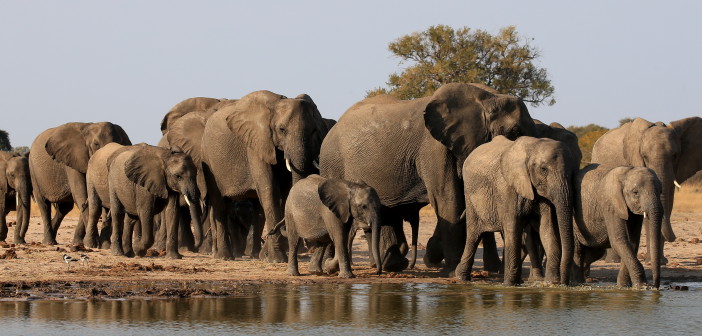
'Too many elephants’ in Africa? Here’s how peaceful coexistence with human communities can help
BY VICKY BOULT - 4 MARCH 2019 - THE CONVERSATION
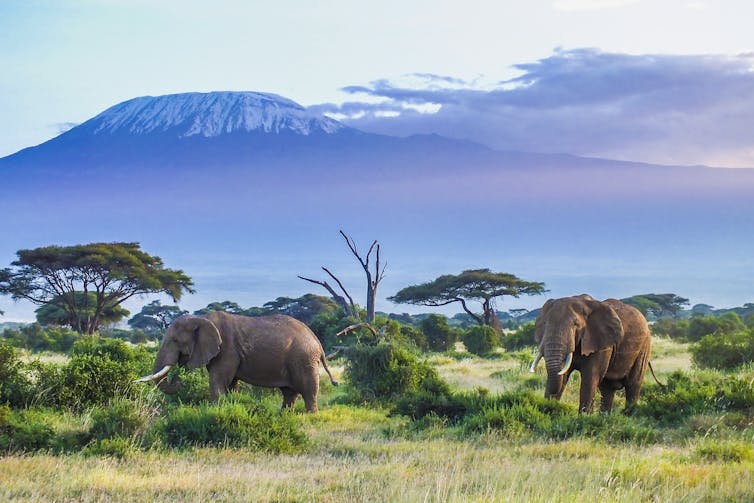
HordynskiPhotography/Shutterstock
Vicky Boult, University of Reading
Africa’s elephant population has plummeted from roughly a million in 1970 to around 400,000 today – a decline which is largely blamed on poaching for their ivory tusks. At its peak in 2011, poaching claimed 36,000 elephants a year, or one every 15 minutes.
Many of us are familiar with these statistics thanks to campaigns to end the ivory trade. But with our attention focused on poaching, an arguably greater threat to Africa’s elephants has emerged. In the time that Africa’s elephant population has crashed, its human population has boomed. The number of people living in Africa has doubled since 1982, reaching a billion in 2009, and is expected to double again by 2050.

While poaching poses an enormous threat to elephants, habitat fragmentation has been less discussed. Vicky Boult, Author provided
To feed and house this growing population, natural habitats have been fragmented by roads and railways and entire swathes have been converted to farmland and settlements. As a result, Africa’s elephants have been squeezed into smaller and increasingly isolated pockets of land. It’s very possible that the future for all of Africa’s elephants will resemble what is currently seen in South Africa.
Here, elephants are largely confined to small, fenced reserves separated by vast human-dominated landscapes. Elephants can’t disperse from these reserves, but their relative protection within them has seen their densities increase. So much so that in stark contrast to the “elephant extinction” narrative we’re used to, some consider South Africa’s reserves to have “too many elephants”.
An excess of elephants?
Elephants play a crucial role in Africa’s savanna ecosystems as seed dispersers. Their dung recycles valuable nutrients and by feeding on trees they maintain the savanna’s matrix of woodland and grassland and the biodiversity it supports.
However, over prolonged periods, high elephant densities can reduce tree cover, which shrinks woodland and expands grassland habitats. This may threaten browsing species, such as black rhinoceros and bushbuck, for which trees provide food and shelter.
Managing elephants to prevent habitat change and preserve biodiversity has a long history. Culling programmes continued into the late 20th century and only ended in Kruger National Park in 1994. Culling remains a “last resort” for managing elephants in South Africa and there have been recent calls to resume culling operations in Botswana.
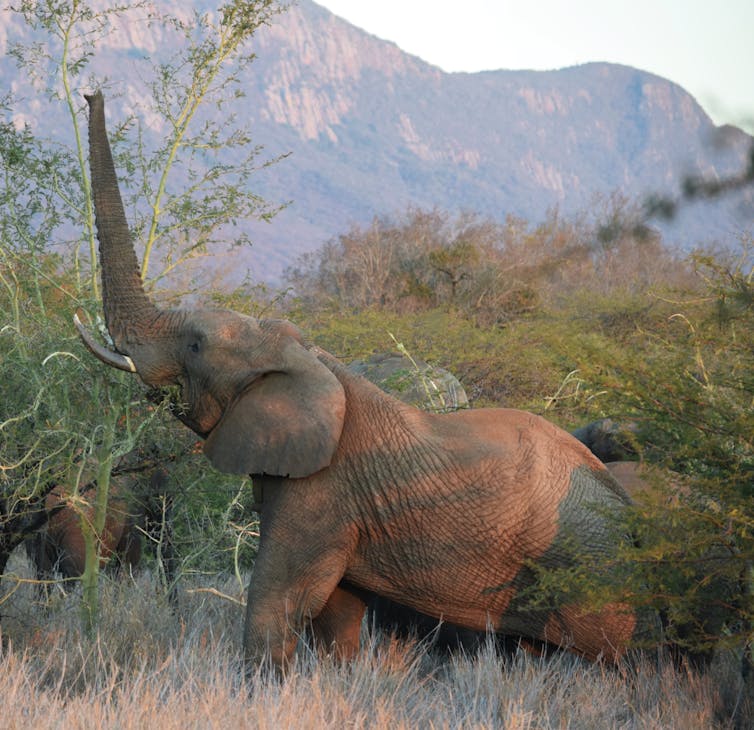
Elephant feeding on a fever tree (Acacia xanthophloea) – a tree species heavily impacted by high elephant densities. Vicky Boult, Author provided
Culls have now largely been replaced by non-lethal approaches, including translocating elephants to other areas and contraceptives to reduce birth rates.
However, all management interventions cause some degree of stress for elephants. There’s always a small risk with using anaesthetics and hormonal contraceptives can alter an elephant’s behaviour.
The fundamental question over the future of Africa’s elephants is whether we are happy to allow them to exist only where they are heavily managed. If so, then we’ll need more research to understand the most effective and ethical ways of managing elephants. If not, then securing more space for elephants alongside human communities could be the answer.
To spare or share
This boils down to an old debate – to spare land or share it. Land sparing means separating pristine wildlife habitats from areas of human activity while land sharing involves maintaining biodiversity within landscapes shared by humans. But which is best for conservation?
South Africa shows us what land sparing means for elephants – expensive, ongoing management in densely populated reserves. The alternative land sharing approach gives elephants greater access to Africa’s landscapes, but relies on coexistence between people and elephants.
At present, land sharing systems outside of Africa’s national parks and reserves are fragile. Human-elephant interactions can threaten the lives of both parties but strategies exist to help coexistence.
At the heart of all of them is an understanding that there must be clear benefits to humans in sharing space with elephants. The revenue from tourists paying to see elephants can provide direct employment but education programmes are also necessary to help people understand how elephants benefit the wider ecosystem.
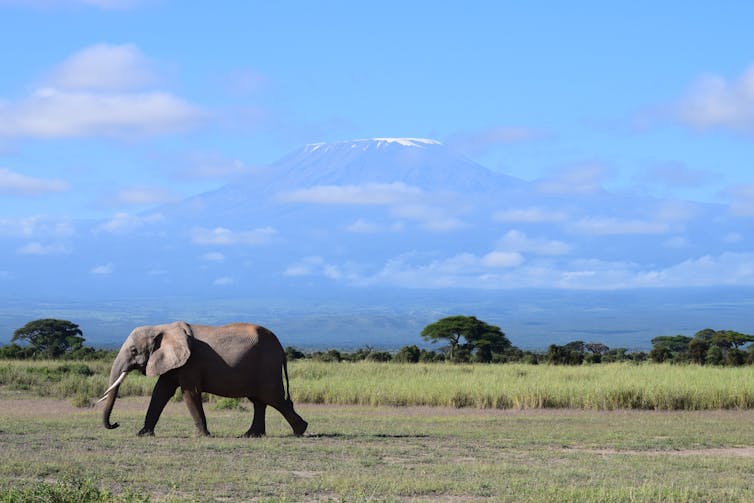
In Amboseli, Kenya, elephants share over 80% of their range with livestock and crop farmers. Vicky Boult, Author provided
Livelihoods outside agriculture must be encouraged to reduce pressures on habitats and wildlife while providing stable incomes in the face of changing environments. Thoughtful land management and planning should ensure vital elephant habitats are protected.
Groups across Africa are already working on solutions which can deliver this. Alongside tourism, projects have emerged which generate revenue from elephants without harming them or the environment, such as producing paper and gifts made from elephant dung.
The charity Save the Elephants teaches local children about the benefits of living in harmony with elephants and organisations such as the Amboseli Ecosystem Trust have started working with conservationists, politicians and local communities to plan how coexistence can be achieved.
Land sharing between humans and elephants will depend on this kind of collaboration between governments, conservation groups and local communities. If people want more for Africa’s elephants than confinement to heavily managed reserves, then everyone needs to be consulted. Only then can there be hope for peaceful coexistence between people and elephants.
Vicky Boult, Postdoctoral Researcher in Conservation Biology., University of Reading
"Education is the most powerful weapon which you can use to change the world." Nelson Mandela
The desire for equality must never exceed the demands of knowledge
The desire for equality must never exceed the demands of knowledge


